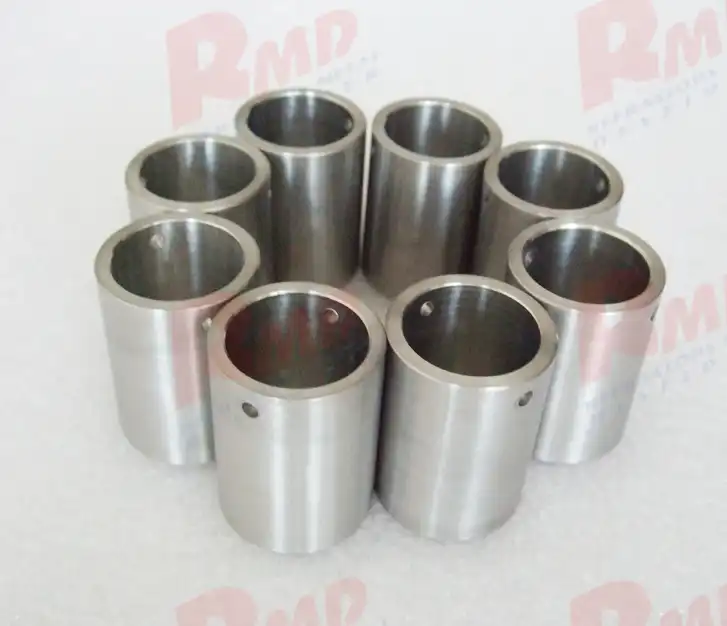Manufacturing Process of Tungsten Crucibles

Powder Metallurgy Techniques
The journey of creating a tungsten crucible begins with fine tungsten powder. This powder undergoes a series of precise steps, including compaction and sintering. During compaction, the powder is pressed into a mold that gives the crucible its initial shape. The sintering process then heats the compacted powder to temperatures just below tungsten's melting point, causing the particles to fuse together. This results in a dense, solid structure that forms the foundation of the crucible.
Machining and Shaping
After sintering, the tungsten blank requires further refinement. Advanced machining techniques come into play, utilizing specialized tools capable of working with this exceptionally hard material. Computer Numerical Control (CNC) machines often handle the precision cutting and shaping needed to achieve the final crucible design. This stage is crucial for ensuring the crucible meets exact specifications for wall thickness, capacity, and any custom features required for specific applications.
Surface Treatment and Finishing
The final phase in manufacturing tungsten crucibles is critical and involves meticulous surface treatment and finishing processes. This stage often includes polishing to achieve a smooth interior surface, which is essential for various applications as it helps prevent material adhesion and facilitates easy cleaning. In addition to polishing, some crucibles may undergo additional treatments such as coating or alloying, aimed at enhancing specific properties like oxidation resistance or electrical conductivity. These modifications are tailored to meet the requirements of their intended use, ensuring optimal performance and durability in demanding environments.
Properties and Advantages of Tungsten Crucibles
Thermal Stability
One of the most remarkable properties of tungsten crucibles is their thermal stability. With a melting point of 3422°C (6192°F), tungsten remains solid at temperatures that would liquefy or vaporize most other materials. This extraordinary heat resistance allows tungsten crucibles to maintain their structural integrity in extreme thermal environments, making them indispensable for high-temperature applications in metallurgy, materials science, and advanced manufacturing processes.
Chemical Inertness
Tungsten crucibles exhibit exceptional chemical inertness, particularly at elevated temperatures. This property is crucial when working with reactive materials or in corrosive environments. The crucibles resist attack from many molten metals, salts, and aggressive chemicals, preserving the purity of the materials they contain. This chemical stability ensures that experiments or production processes remain uncontaminated, a critical factor in industries such as semiconductor manufacturing and rare earth element processing.
Mechanical Strength
The mechanical strength of tungsten crucibles is another significant advantage. Even at high temperatures, tungsten maintains impressive structural integrity, resisting deformation and creep. This strength allows for the design of thin-walled crucibles that offer excellent heat transfer properties without compromising on durability. The robustness of tungsten crucibles also translates to longer service life and reduced replacement frequency, making them a cost-effective choice for demanding industrial applications.
Applications of Tungsten Crucibles
Metallurgy and Materials Processing
In the realm of metallurgy and materials processing, tungsten crucibles play a pivotal role. They are extensively used for melting and alloying high-temperature metals and ceramics. The ability of tungsten crucibles to withstand extreme heat makes them ideal for processes involving refractory metals, superalloys, and advanced ceramics. Researchers and manufacturers rely on these crucibles to develop new alloys and materials with enhanced properties, pushing the boundaries of what's possible in fields like aerospace engineering and high-performance electronics.
Semiconductor Industry
The semiconductor industry heavily depends on tungsten crucibles for various critical processes. In the production of single-crystal silicon, which forms the basis of most electronic devices, tungsten crucibles are used to contain the molten silicon during the crystal growth process. Their high purity and resistance to contamination ensure the production of high-quality semiconductor materials. Additionally, tungsten crucibles are utilized in the deposition of thin films and the growth of compound semiconductors, contributing to the advancement of microelectronics and optoelectronic devices.
Evaporation Coating Applications
Tungsten crucibles and boats have found a significant niche in evaporation coating processes. In this application, the crucible or boat serves as a container and heating element for materials that are to be vaporized and deposited as thin films on various substrates. The high melting point and low vapor pressure of tungsten make it an excellent choice for this purpose. Industries such as optics, solar panel manufacturing, and flexible electronics benefit from the precision and reliability offered by tungsten crucibles in evaporation coating systems. The ability to maintain stable temperatures and uniform heating ensures consistent film deposition, critical for producing high-quality coatings with specific optical, electrical, or protective properties.
Conclusion
Tungsten crucibles represent a pinnacle of materials engineering, offering unparalleled performance in extreme conditions. Their unique combination of thermal stability, chemical inertness, and mechanical strength makes them indispensable across various high-tech industries. As we continue to push the boundaries of materials science and manufacturing, the role of tungsten crucibles in enabling new discoveries and technologies remains crucial. If you want to get more information about this product, you can contact us at rmd1994@yeah.net.